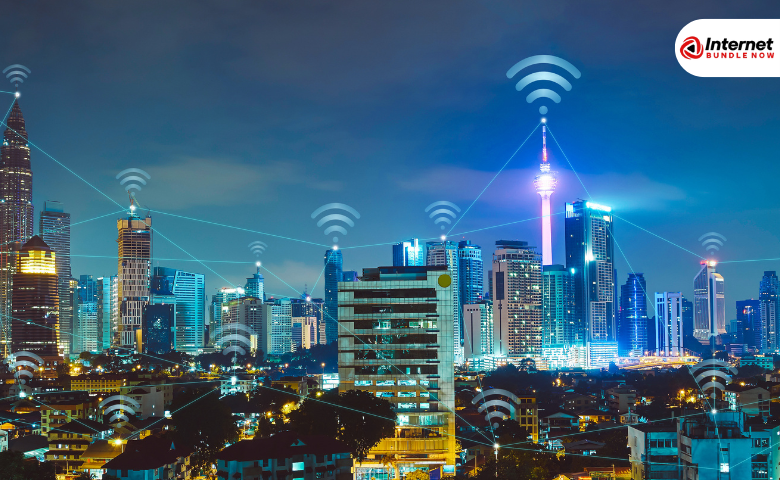- TV
How to Get Premium Channels with Your Cable TV Bundle?
Access to exclusive entertainment content is a priority for many viewers seeking a richer television experience. Premium chan...
Explore More
In today’s digital world, staying connected is essential, and nothing is more frustrating than slow or unreliable Wi-Fi. Whether you're working from home, streaming your favorite shows, or gaming online, a strong Wi-Fi connection is critical. At Internet Bundle Now, we understand how important a smooth, fast connection is, which is why we’ve put together these essential Wi-Fi troubleshooting tips. Let’s help you boost your signal and improve your connection so you can get the most out of your Internet Service Provider.
The first step in solving any Wi-Fi issue is the basics. Start by restarting your router and any connected devices. Sometimes a simple reboot clears up many of the temporary issues. Next, check for any service outages in your area by contacting your Internet Customer Service. This ensures that the issue isn't on your provider's side. Finally, double-check that all cables are connected securely to your modem and router.
If you're experiencing weak Wi-Fi signals in certain areas of your home, it's time to assess your Wi-Fi signal strength. Use a Wi-Fi analyzer app to map out the signal coverage in your home and identify dead zones or areas with poor reception. Signal strength is affected by interference from walls, floors, and even appliances. Be aware of where your signal drops and think about expanding coverage if necessary.
Where you place your router matters more than you think! Ensure that the router is placed centrally in your home, avoiding locations near walls or metal objects. Positioning your router in a high, open space improves signal range and reduces interference. Keep it away from electronic devices that may block the signal, such as microwaves and cordless phones.
Many household devices can interfere with Wi-Fi signals, reducing performance. Devices like microwaves, baby monitors, and Bluetooth devices may impact your connection. If you notice interference, try changing your router’s frequency band from 2.4GHz to 5GHz. The 5GHz band offers faster speeds with less interference, though with shorter range. Another solution is to connect devices directly via Ethernet cables when possible, which bypasses Wi-Fi altogether.
One of the most overlooked troubleshooting steps is updating your router’s firmware. Outdated firmware can cause connectivity issues and security vulnerabilities. Log into your router settings and check for updates regularly. Similarly, update the software on your connected devices, including laptops, smartphones, and smart TVs. Updated software ensures compatibility and maximizes performance with modern Internet Plans.
An unsecured Wi-Fi network can invite unwanted guests, slowing down your connection and leaving you vulnerable to cyber threats. Strengthen your network by using a strong password and enabling WPA3 encryption. This prevents unauthorized access, ensuring only you and your household are using the connection. Disable unused features like WPS (Wi-Fi Protected Setup) for added security. These steps help maximize your Wi-Fi speed and protect sensitive data.
If you find that certain areas of your home still have poor Wi-Fi coverage, consider investing in Wi-Fi extenders or a mesh network system. Wi-Fi extenders work by boosting the existing signal, helping it reach further into your home. For larger homes or multiple floors, a mesh network distributes coverage evenly and ensures consistent performance throughout. You may also want to upgrade your router to one that supports the latest standards, such as Wi-Fi 6, which offers superior speed and connectivity.
Tweaking your router settings can make a significant difference in Wi-Fi performance. For instance, you can adjust the transmission power of your router to increase signal strength. Many modern routers allow you to set Quality of Service (QoS) settings, which let you prioritize certain devices over others, such as your gaming console or work laptop. Changing your DNS settings to a faster, more reliable service can also help improve loading speeds on websites.
If your Wi-Fi is working but your internet still seems slow, the issue may be with your connection from the Internet Service Provider. Run an internet speed test to check if you're getting the speeds you're paying for in your Internet Plans. Compare the test results to your plan’s expected speeds. Sometimes, your provider may be throttling your bandwidth during peak hours. If this is the case, you may need to contact Internet Customer Service for help.
If basic troubleshooting hasn't solved your Wi-Fi problems, consider more advanced solutions. Powerline adapters are a great option for homes with poor Wi-Fi coverage. They transmit internet signals through your home’s electrical wiring, effectively turning any outlet into an Ethernet port. Another option is switching between the 2.4GHz and 5GHz bands depending on your location and needs. 5GHz provides faster speeds but over shorter distances, while 2.4GHz offers broader coverage.
There are times when no amount of troubleshooting can solve your Wi-Fi issues, and it's time to contact your Internet Service Provider. If you’ve followed all the steps and still experience problems, your provider can help identify the issue, whether it's with your modem, signal, or infrastructure. Don’t hesitate to reach out to Internet Customer Service to check if there are any service issues in your area or if you might need to upgrade to a higher-tier plan to meet your needs.
Wi-Fi issues are common, but with the right steps, you can significantly improve your connection and avoid frustration. From router placement and reducing interference to updating firmware and investing in extenders, there are many ways to boost your Wi-Fi performance. At Internet Bundle Now, we offer a variety of Internet Plans to suit your needs and ensure you always stay connected. If you ever encounter issues beyond these tips, our reliable Internet Customer Service team is here to assist you.
Latest insights, tips, and updates from our experts.
George
Wi-Fi Troubleshooting Tips Boost Your Signal and Improve Your Connection